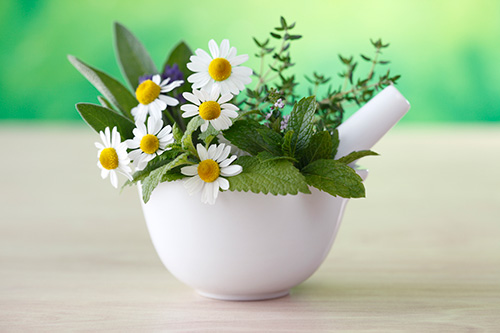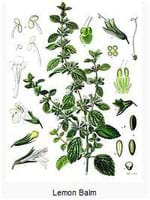Authored by Dr. Mary James, ND
Long before Pepcid®, Alka-Seltzer®, TUMS® or Pepto-Bismol® hit the shelves of your local “apothecary,” people everywhere regularly turned to the herbs that were already growing around them to heal their digestion.

Today, many of these same herbs for digestion remain in widespread use for common digestive system problems. You can self-treat bouts of nausea, motion sickness, morning sickness, vomiting, heartburn, dyspepsia, bloating, belching, flatulence or diarrhea, when occasional or mild, frequently to good effect.
You should discuss with a qualified professional more serious or persistent digestive disorders, such as intestinal infections, diarrhea, chronic acid reflux, inflammatory bowel disease (e.g., Crohn’s and ulcerative colitis) or peptic ulcers, among others. While you can also treat these more problematic digestion concerns with herbs, results can be much more variable, and professional guidance is important to ensure a successful outcome.
Meant for the milder or occasional GI upset, this is an introduction to a handful of gentle, “kitchen-garden” remedies that are often effective. Most women can safely use these herbs as antidotes to the occasional digestion upsets we nearly all experience from time to time. (If your GI symptoms persist or worsen, then consult with a qualified healthcare professional for assistance.)
The botanical nervines — herbs for digestion
For healthy digestive function, our bodies must be in a relaxed state. When we’re in an anxious, fight-or-flight state, digestion always takes a back seat to dealing with the stress or stressor. When we eat in this state, it’s common to develop digestive disturbances. If emotional upset disrupts your digestion, try botanical nervines. They have a pronounced positive effect on the nervous system that then naturally provides relief to the digestive system. They do this by reducing the stress response — an adaptive triggering of the sympathetic nervous system accompanied by a simultaneous turn-off of any other bodily function not required in an emergency for survival. In essence, these herbs help heal our digestion by making us more serene.
Certain plants have adaptogenic effects. This means they can have opposite actions — relaxing or stimulating — depending on what is needed at a particular moment in time in a person’s body. In the case of nervines, some herbs can function both as relaxant nervines — which are thought to work by relaxing constricted or contracted tissues in the nervous system — and as stimulant nervines — thought to stimulate lax or stagnant tissues in the nervous system. Other herbs are more nutritive for the nervous system. Here are five great botanical herbs that aid digestion.

Peppermint (Mentha x piperita and Mentha spp.) for digestion
The use of essential oil of peppermint as a digestive aid probably dates back to ancient Greece. Several thousand years later, a body of scientific research now exists that supports its use, particularly in the form of delayed-release, enteric-coated peppermint oil capsules, for symptomatic relief of irritable bowel syndrome. An enteric coating on the capsule allows for the oil of peppermint to pass undegraded, through the more acidic upper regions of the GI tract, to the lower intestine, where, as reported in the British Medical Journal more than 30 years ago, it has the effect of a gentle smooth-muscle relaxant, serving to calm digestive spasm, inhibit GI contraction, relieve gas, and reduce pain and discomfort.
What’s the difference between a tea, a tisane, an infusion, a decoction, and a tincture? Here are some of the many methods we employ to capture the essential oils and additional active constituents found in medicinal plants.
- Tisane — an herbal “tea” brewed in water from any plant materials other than the true tea plant (Camellia sinensis)
- Infusion — similar to a tisane or decoction, but generally more potent, with the plant materials left to steep in oil or boiling water for some time
- Decoction — prepared by boiling ground-up or mashed plant materials in water, then straining the preparation
- Tincture — an extract prepared by placing herbs or other plant material in a jar with ethanol or another form of alcohol, allowing it to stand for a couple weeks or longer, shaken periodically, then strained. Vinegar or glycerin is sometimes used in place of alcohol.
A cautionary note: people tolerate enteric-coated peppermint at the commonly recommended dosages, but higher doses may cause adverse effects. Anyone with GI reflux, hiatal hernia or kidney stones should also use caution. Please see a qualified naturopath or herbalist for advice and guidance.
Additional applications include its topical use: Soak a clean towel in hot water containing a few drops of peppermint oil, then apply to the abdomen for 20–30 minutes, two to three times daily, as a comforting compress for bloating or distention.
But you need not suffer from a digestive disorder to enjoy peppermint, at least in the form of peppermint tea. Peppermint tea has no adverse reported reactions. And it is likely the most popular, single-ingredient herbal tisane. The most delicate as well as the most “cast-iron” of stomachs will find an after-dinner cup of peppermint tea quite soothing, thanks to its delicate aroma, flavor, and all the beneficial effects on digestion described above. If you have a sweet tooth but high-carb desserts bother your digestion or your sleep — especially after the evening meal — try it with or without a dollop of honey or agave nectar in place of dessert. Your digestion will thank you!

Chamomile (Matricaria recutita, M. chamomilla, Chamomilla recutita) for digestion
Chamomile is a botanical nervine that is popular for digestive symptoms. You can use it singly or in combination, as a tisane, tincture or homeopathically. Sometimes referred to as “mother of gut,” practitioners have prescribed chamomile in the treatment of both acute and chronic gastric distress, such as inflammation and cramps of the digestive organs. Though scientific studies on humans are limited, research on extracts of dried chamomile flowers demonstrates spasmolytic (spasm-dissolving) and anxiolytic (anxiety-dissolving) effects. Along with chamomile’s antimicrobial and anti-inflammatory properties, these actions may explain its overall soothing effect on digestion.
Scientists have isolated numerous chemical compounds from chamomile flowers, including apigenin. We do not fully understand the pharmacologic effects of this phenolic flavonoid, but some have noted that apigenin has an affinity for GABA receptors in the brain. There it may exert a natural inhibitory effect on our central nervous system. (This same mechanism explains the action of some barbiturates and anti-anxiety drugs.) Generally recognized as safe and well tolerated, chamomile may, however, cause rare allergic symptoms in those sensitive to plants in the sunflower (Asteraceae), celery (Umbelliferae), or onion (Amaryllidaceae) families.

Lemon balm (Melissa officinalis); rosemary (Rosmarinus officinalis); and valerian (Valeriana officinalis) for digestion
Often formulated into combination products, lemon balm, rosemary and valerian are three additional botanical nervines that can help dispel digestive spasm, relieve excess gas, calm queasiness as well as diminish pain. Clinical evidence supporting their use is somewhat limited. But based upon observation and available research, people tolerate these herbs well. You can take them orally to help reduce symptoms of digestion disturbance.
Lemon balm, also known as bee balm or Melissa, is another member of the mint family. It has been used internationally for centuries to allay gas, spasm, and dyspepsia, as well as to increase “calmness.” Rosemary in particular has antispasmodic effects. The German Commission E has approved the use of rosemary leaf for the treatment of dyspepsia. Research into the active constituents of medicinal plants often turns up biochemical similarities between different species. Rosemary and lemon balm, for instance, share the polyphenol compound known as rosmarinic acid. Valerian, however, is better known for its effects on restlessness and nervous sleep disturbance. It is often formulated with other herbs such as hops or lemon balm for use as a mild sedative or anxiolytic. Historically, some have taken valerian for gastrointestinal problems such as intestinal spasm and flatulence (gas).
Other herbs to aid digestion
Fennel (Foeniculum vulgare) for digestion

With origins in traditional Ayurvedic, Mid-Eastern and Mediterranean Basin medicine, preparations of fennel leaves and seeds help prevent and relieve gassiness as well as diminish bloating, heartburn and constipation. Fennel is also believed to promote the secretion of digestive enzymes and to improve a weak appetite. For infants with colic, fennel has also been traditionally given as a tea in combination with other medicinal herbs, or as a fennel seed emulsion. In one small trial, there was significant relief of colic symptoms, with no side effects reported. Fennel is generally recognized as safe, though may rarely cause an allergic reaction. Do not use fennel if you are pregnant.
Ginger root (Zingiber officinale) for digestion

Ginger root has been used and studied extensively over time for a wide range of biological activities. There is considerable experimental data, collected by scientists worldwide, regarding ginger root’s ability to strengthen and mildly stimulate the stomach and intestines, as well as to calm nausea and vomiting. The active constituents are gingerols, chemical compounds that function as inhibitors of pro-inflammatory chemicals called prostaglandins. Travelers have relied on ginger formulations to soothe queasiness both on land and sea — even (experimentally) in space! — as well as by women in first-trimester pregnancy to quell morning sickness. Some of the diverse properties attributed to ginger include anti-ulcer, digestive, antimicrobial, antioxidant, anti-inflammatory, anti-nausea (anti-emetic), and anti-motion sickness. You can use it in the form of fresh ginger root or ginger juice, in teas or decoctions, ginger ale, or dried and encapsulated ginger root powder.
Digestive bitters
A bitters formulation may be an infusion, tincture or distillation (usually in some type of spirits), of aromatic herbs, barks, fruits and roots. Bitters have a range of medicinal qualities, but the primary effect is to improve digestion. This occurs predominantly through enhanced production of digestive enzymes, by nutritive support of the epithelial lining of the GI tract, and by reducing intestinal irritation and inflammation.
Many different bitters formulations exist, handed down through the ages from elders familiar with the native flora. Swedish bitters, probably the most well-known here in the Western world, has its origins in 16th-century Europe. There people used it for a number of GI symptoms, including stomach cramps. One “original” recipe is believed to have been a tincture of aloe, myrrh, saffron, senna leaves, camphor, Angelica root, rhubarb root, and other ingredients of a somewhat esoteric nature, in a mixture of several different spirits.
Nowadays, there are a number of different preparations labeled “Swedish bitters” that contain more variable combinations of herbs from around the globe. Turmeric (Curcuma longa), cardamom seed, milk thistle seed, fennel seed, dandelion root, gentian root, ginger root, and other herb leaves, flowers, bark, roots, or seeds are among the many plants used. Citrus essences, such as bitter orange or lemon, are frequently added as flavorings to bitters formulations.
Angostura bitters, which most people think of as a cocktail ingredient, was originally compounded as a remedy for stomach maladies. A few drops in mineral water ‘to taste’ makes a welcome digestion-enhancing alternative to the drink menu list of sugary sodas, alcoholic beverages, and fruit juices. It owes its refreshing taste to the bark of the Angostura tree and gentian root, among other ingredients.
Herbs for digestion — more than just for taste
These are just a few of the many herbs with a long tradition of use for upset digestion. Look for these herbs at your health food or grocery store, in your garden, or at the office of a local naturopath or herbalist, and give them a try. Keep in mind that no one treatment will work for everyone in the same way, and there are myriad additional components to a natural approach to healing digestion.
And as always, before using herbs to treat an ongoing or chronic digestive condition, it’s wise to consult a qualified herbalist, naturopath, practitioner of Oriental medicine, or Functional Medicine practitioner. You can heal your digestion naturally, given time and the proper support, but sometimes it takes professional assistance — from someone with knowledge and expertise — to not only rule out potentially more serious conditions, but also to create a platform from which you can then draw on Nature’s herbal compendium to maintain your digestive wellness.
1Hoffmann DL. Nervine. Healthy.net Web site. https://www.healthy.net/scr/article/?Id=1491. Accessed March 31, 2014.
2Kliger B, Chaudhary S. Peppermint oil. Am Fam Physician. 2007;75(7):1027–1030. American Family Physician Web site. https://www.aafp.org/afp/20070401/1027.html. Accessed March 31, 2014.
3Rees WD, Evans BK, Rhodes J. Treating irritable bowel syndrome with peppermint oil. Br Med J. 1979 Oct 6;2(6194):835-6.
4Feng, X. [Effect of peppermint oil hot compresses in preventing abdominal distension in postoperative gynecological patients.] Zhongua Hu Li Za Zhi. 1997;32 (1):577–578.
5 [No authors listed] Matricaria chamomilla (German chamomile). Monograph. Altern Med Rev. 2008 Mar;13(1):58-62.
6 Viola H1, Wasowski C, Levi de Stein M, et al. Apigenin, a component of Matricaria recutita flowers, is a central benzodiazepine receptors-ligand with anxiolytic effects. Planta Med. 1995;61(3):213–216.
7 Kennedy DO, Wake G, Savelev S, et al. Modulation of mood and cognitive performance following acute administration of single doses of Melissa officinalis (lemon balm) with human CNS nicotinic and muscarinic receptor-binding properties. Neuropsychopharmacology. 2003;28(10):1871–1881.
8 Rosemary. University of Maryland Medical Center Web site. https://umm.edu/health/medical/altmed/herb/rosemary. Accessed March 31, 2014.
9 [No authors listed] Monograph. Valeriana officinalis. Altern Med Rev. 2004 Dec;9(4):438-441.
10 [No authors listed] Monograph. Valeriana officinalis. Altern Med Rev. 2004 Dec;9(4):438-441.
11 Fennel. WebMD Web site. https://www.webmd.com/vitamins-supplements/ingredientmono-311-FENNEL/?activeIngredientId=311&activeIngredientName=FENNEL. Accessed March 31, 2014.
12 Ernst E1, Pittler MH. Efficacy of ginger for nausea and vomiting: a systematic review of randomized clinical trials. Br J Anaesth. 2000 Mar;84(3):367-371.
13 Ding M, Leach M, Bradley H. The effectiveness and safety of ginger for pregnancy-induced nausea and vomiting: a systematic review. Women Birth. 2013 Mar;26(1):e26-30.
14 Bode AM, Dong Z. The Amazing and Mighty Ginger. In: Herbal Medicine: Biomolecular and Clinical Aspects. 2nd ed. New York, NY: Taylor & Francis Group, LLC; 2011. https://www.ncbi.nlm.nih.gov/books/NBK92775/. Accessed March 31, 2014.
15 Bitters: The Revival of a Forgotten Flavor. January 17, 2011. Weston A. Price Web site. https://www.westonaprice.org/basics/bitters-the-revival-of-a-forgotten-flavor. Accessed March 31, 2014.
16 Bitters: The Revival of a Forgotten Flavor. January 17, 2011. Weston A. Price Web site. https://www.westonaprice.org/basics/bitters-the-revival-of-a-forgotten-flavor. Accessed March 31, 2014.










